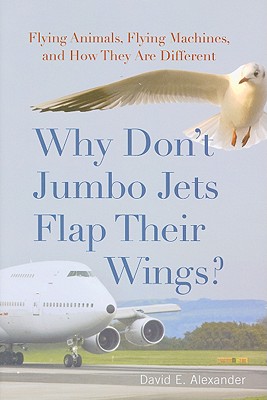You are here
Back to topWhy Don't Jumbo Jets Flap Their Wings?: Flying Animals, Flying Machines, and How They Are Different (Hardcover)
$38.95
Special Order
Description
What do a bumble bee and a 747 jet have in common? It’s not a trick question. The fact is they have quite a lot in common. They both have wings. They both fly. And they’re both ideally suited to it. They just do it differently.
Why Don’t Jumbo Jets Flap Their Wings? offers a fascinating explanation of how nature and human engineers each arrived at powered flight. What emerges is a highly readable account of two very different approaches to solving the same fundamental problems of moving through the air, including lift, thrust, turning, and landing. The book traces the slow and deliberate evolutionary process of animal flight—in birds, bats, and insects—over millions of years and compares it to the directed efforts of human beings to create the aircraft over the course of a single century.
Among the many questions the book answers:
- Why are wings necessary for flight?
- How do different wings fly differently?
- When did flight evolve in animals?
- What vision, knowledge, and technology was needed before humans could learn to fly?
- Why are animals and aircrafts perfectly suited to the kind of flying they do?
David E. Alexander first describes the basic properties of wings before launching into the diverse challenges of flight and the concepts of flight aerodynamics and control to present an integrated view that shows both why birds have historically had little influence on aeronautical engineering and exciting new areas of technology where engineers are successfully borrowing ideas from animals.
About the Author
DAVID E. ALEXANDER is an assistant professor of entomology in the ecology and evolutionary biology department at the University of Kansas. He is the author of Nature's Flyers: Birds, Insects, and the Biomechanics of Flight.
Praise For…
"This book lucidly captures the comparative aerodynamics of winged animals and aircrafts with great skill and clarity. This is science writing at its best and is a valuable reference for the specialist as well as for the casual enthusiast of flight."
Sankar Chatterjee, Paul Whitfield Horn Professor of Geosciences, Texas Tech University
"David Alexander has produced an astonishingly readable and enjoyable romp through topics in flight mechanics. This book cuts through the obtuse and obscure without sacrificing scholarship."
Catherine Loudon, University of California, Irvine
"You'll find no more transparently clear explanation of all that goes on when you fly in an airplane. Or, in a seamlessly integrated account, what
happens when a bird, bat, or bumblebee does the same."
Steven Vogel, James B. Duke Professor, Emeritus, Department of
Biology, Duke University
"This is a well-written and thought-provoking book telling a unique story of both the history and the physics of natural and mechanical flight."
James DeLaurier, Professor Emeritus, University of Toronto Institute for Aerospace Studies
